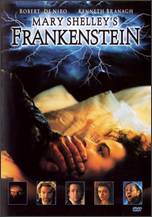Mary Shelley’s Frankenstein
 for horrific images.
for horrific images.
Reviewed by: Brett Willis
CONTRIBUTOR
| Moral Rating: | Very Offensive |
| Moviemaking Quality: |
|
| Primary Audience: | Adults |
| Genre: | Sci-Fi Horror |
| Length: | 2 hr. 3 min. |
| Year of Release: | 1994 |
| USA Release: |

| Featuring |
|---|
| Robert De Niro, Kenneth Branagh, Tom Hulce, Helena Bonham Carter, Aidan Quinn, Ian Holm, Richard Briers, John Cleese |
| Director |
|
Kenneth Branagh |
| Producer |
| Francis Ford Coppola, James V. Hart, John Veitch, Fred Fuchs, Kenneth Branagh, David Parfitt |
| Distributor |
The publicity says this film version of the familiar Frankenstein story is faithful to the novel. That’s pretty close to true, although there are some new twists. And since the novel, written by a woman, wasn’t just a “monster” story but also a study of human nature and of discrimination against those who are different, this adaptation could be considered worthwhile on that count. Not to mention the “mad scientist playing God” angle, which is certainly relevant today. The novel’s alternate title was “The Modern Prometheus” (in mythology, Prometheus was the rebellious Titan who gave mankind the gift of fire and otherwise brought benefits to man that should have been reserved for the gods alone).
The opening is 1794. An expedition led by Captain Walton (Aidan Quinn) is trying to sail to the North Pole. Unmindful of hazards or crewmembers’ loss of life, Walton is the type who doesn’t take “no” for an answer and tries to do what no one has done before. He’s about to meet his match. He discovers Dr. Victor Frankenstein (Kenneth Branagh) wandering half-dead on the ice sheet. And there’s someone else out there too—someone who can kill sled dogs bare-handed.
Frankenstein tells the Captain the entire story in flashback. In 1773, Victor was a boy in Geneva. One day his father, Baron Frankenstein (Ian Holm), surprised Victor with an adopted sister Elizabeth, whose parents had died in an epidemic. As they grew up, Victor and Elizabeth fell in love and intended to be married (which was socially acceptable). But Victor’s mother died giving birth to his baby brother William. Victor trained as a physician, intending to do something to “stop death.” Nothing wrong with that; many of the world’s finest physicians have had the same aim, triggered by similar circumstances. But in the pursuit of thwarting death, there are some things that “cross the line.”
The guts of the story take place in 1793, while Victor is a medical student in Ingolstadt. He proclaims to his friend and fellow-student Henry Clairval (Tom Hulce) that he’s going to study and follow the “forbidden” experiments of others before him, including one of his instructors Dr. Waldeman (John Cleese) who has now disavowed those experiments and returned to the mainstream. Heedless of ridicule, censure and Prof. Waldeman’s dire warnings, Victor perseveres.
There’s a plague in the countryside, and the physicians and medical students try to immunize the population and stop the disease from breaking out in their city. [This is a slight anachronism; the first vaccination—Jenner’s cowpox/smallpox—began experimentally in 1796 and was applied on a large scale in 1798.] A peg-legged man (Robert De Niro) balks at the idea of vaccination. When pressured, he kills Dr. Waldeman and is subsequently executed.
Having read Dr. Waldeman’s secret journals, Frankenstein takes parts from several bodies, including those of Dr. Waldeman and his killer, and sews these “materials” into a composite body. Then, with an elaborate technique involving acupuncture, amniotic fluid and electric eels, he gives his creature “life”.
Those who know the story can predict the broad outline from here on. By refusing to listen to advice, Victor has jeopardized his entire family and his future marriage to Elizabeth (Helena Bonham Carter). The monster (De Niro) is going to make Victor’s life as miserable as his own.
The acting is very good all around. The special effects work, and De Niro’s interpretation of the monster, bring us a message essentially the same as that of the novel.
One of the most touching sequences in the original story was omitted from the 1931 Boris Karloff version of “Frankenstein” but was used in one of the sequels (“Bride of Frankenstein,” I believe). That sequence also appears here. After being driven from society, the monster takes refuge in a secret cubbyhole of a farmhouse and, observing the humble country family through a crack in the walls, learns about the normal human love and affection that he cannot share. When the patriarch of the family (who is blind) is alone, the monster speaks with him and is “accepted”. But the man’s son, returning unexpectedly, drives the monster off.
Content Warnings: The violence includes several on-screen deaths (hanging, burning, heart ripped from body, etc.). There’s little or nothing in the way of foul language. The special-effects nudity involved in assembling and animating the monsters is grotesque but non-explicit. Victor’s wedding night proceeds only as far as some passionate smooching and groping before it’s interrupted. The creatures Victor creates—the original monster and a second, female one—appear hideous, yet they evoke our sympathy because their hideousness is in the eye of the beholder and is in any case no fault of their own. Our revulsion should be reserved for people like Victor who arrogantly act without restraint, using their God-given abilities any way they wish. “Lo, this only have I found, that God hath made man upright; but they have sought out many inventions.” (Eccl. 7:29)
Commentary: Although this story is fiction, we now live in a time of great scientific “advances”. The human genome is being mapped and tampered with. In vitro fertilization is common, many embryos are killed or discarded, and the birth mother of many children is not their genetic mother. There are attempts to create human clones and human/human or human/animal chimeras. “Progress” is being made on alleviating or curing diseases of old age by the use of aborted fetal tissue. Parents conceive children just to use them as organ donors for their sick older brothers and sisters. There’s much more, so much that it’s impossible to keep pace with it all. Several years ago, a baby girl received the heart of a baboon; apparently her own heart was defective because her parents were druggies. Of all the groups who could have made political statements at the hospital where the operation was performed, the only one that showed up was an Animal Rights group protesting the use of baboons as donors. Apparently life imitates art; the “playing God” syndrome is alive and well in the medical and scientific community, and is being accepted by the public at large. Like Dr. Frankenstein or the Nazis, today’s consumer wants “results” and isn’t bothering to question the morality of how those results are obtained.


PLEASE share your observations and insights to be posted here.
